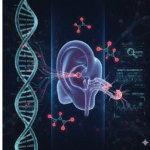Gene inactivation, a process in which the expression of a gene is silenced or disrupted, is an essential aspect of cellular regulation. While gene activation is often discussed in terms of genetic inheritance and the positive functions of proteins, inactivation or silencing of genes can have profound implications for human health. Understanding gene inactivation and its potential links to human disease is crucial in advancing medical research, diagnostics, and therapeutic strategies.
This article explores the mechanisms of gene inactivation, its role in human disease, and the potential for therapeutic interventions aimed at reversing gene silencing or regulating gene expression.
What is Gene Inactivation?

Gene inactivation occurs when a gene, though present in the genome, is unable to be transcribed into RNA and, therefore, does not produce its corresponding protein. This can happen through several mechanisms, including:
- DNA Methylation: Addition of methyl groups to DNA, often at the promoter region of a gene, can prevent transcription factors from accessing the gene, effectively silencing its expression.
- Histone Modifications: The wrapping of DNA around histone proteins is a key regulatory mechanism in gene expression. When histones are chemically modified (e.g., through methylation or acetylation), it can lead to a more condensed, inactive chromatin structure, preventing transcription.
- RNA Interference: Small RNA molecules, such as microRNAs, can bind to messenger RNAs (mRNAs) and prevent their translation into proteins, leading to gene silencing.
- Chromosomal Rearrangements and Mutations: Structural changes in chromosomes, such as deletions or duplications, can cause loss of function in certain genes, effectively inactivating them.
Gene inactivation can either be a normal part of cellular processes or an event that contributes to disease. In many cases, the regulation of gene expression is vital for maintaining healthy cellular function.
The Role of Gene Inactivation in Disease
While gene silencing is a necessary process in normal cellular activities—such as differentiation and response to environmental stimuli—abnormal gene inactivation is implicated in the development of numerous human diseases. Below, we explore several examples of how gene inactivation contributes to disease mechanisms:
1. Cancer
Cancer is one of the most prominent diseases linked to gene inactivation. The development of cancer is a multistep process involving the accumulation of genetic mutations and alterations in gene expression. Many cancer-related genes, such as tumor suppressors, can become inactivated by epigenetic changes, particularly DNA methylation.
- Tumor Suppressor Genes: These genes normally work to prevent uncontrolled cell division, promote DNA repair, and initiate apoptosis (programmed cell death) when cells are damaged. When tumor suppressor genes are silenced, often through hypermethylation of their promoter regions, their protective functions are lost. This allows cells to divide uncontrollably and accumulate mutations, which leads to cancer. A well-known example of a tumor suppressor gene that can be inactivated in cancer is p53. This gene plays a critical role in responding to DNA damage. Inactivation of p53 in many cancers leads to defective cell cycle checkpoints and resistance to apoptosis, making it difficult for the body to control tumor growth.
- Oncogenes: While oncogenes are typically activated in cancer, certain mechanisms of gene inactivation can also contribute to tumor progression. For example, a loss of expression of specific genes involved in controlling cellular checkpoints can lead to unchecked cell division and tumorigenesis.
2. Genetic Disorders
Gene inactivation is also involved in a variety of genetic disorders, particularly those associated with imprinting disorders and X-linked diseases.
- Imprinting Disorders: In these disorders, the expression of certain genes depends on the parent from which the gene is inherited. If the active allele from one parent is silenced due to improper inactivation, it can lead to disease. A well-known example is Prader-Willi Syndrome and Angelman Syndrome, both of which are caused by the loss of function of genes in the same chromosomal region. In Prader-Willi Syndrome, the paternal allele is inactivated, while in Angelman Syndrome, the maternal allele is affected.
- X-Inactivation in Females: In females, one of the two X chromosomes in each cell is randomly inactivated to balance the gene dosage between males (who have only one X chromosome) and females. If X-inactivation fails to occur properly, it can result in diseases, such as Turner Syndrome (where only one X chromosome is present) and X-linked recessive disorders (where the defective gene on the inactivated X chromosome causes disease). X-inactivation can also have a role in the severity and expression of disorders like hemophilia.

3. Neurodegenerative Diseases
Gene inactivation is implicated in various neurodegenerative diseases. Some conditions involve the silencing of protective genes that normally safeguard neurons, leading to progressive loss of function. In other cases, abnormal inactivation of genes involved in synaptic function or neuroprotection can trigger disease onset.
- Alzheimer’s Disease: Epigenetic modifications, including DNA methylation and histone modification, have been found to play a role in Alzheimer’s disease by silencing genes that protect neurons. Genes involved in the amyloid precursor protein (APP) pathway, which leads to the formation of amyloid plaques, may be influenced by gene inactivation, promoting disease progression.
- Parkinson’s Disease: Similar mechanisms involving gene silencing are observed in Parkinson’s disease, where the inactivation of genes involved in dopamine production and neural maintenance contributes to the progressive degeneration of dopaminergic neurons.
4. Autoimmune Diseases
Autoimmune diseases, such as lupus or rheumatoid arthritis, involve the body’s immune system attacking its own tissues. Abnormal gene inactivation can contribute to these diseases by silencing genes that regulate immune responses or promote immune tolerance.
- Toll-like Receptors (TLRs): These receptors play a vital role in recognizing pathogens and activating the immune system. In autoimmune diseases, the inactivation or misregulation of these genes can lead to an inappropriate immune response, attacking healthy cells.
Therapeutic Implications of Gene Inactivation
Understanding the role of gene inactivation in human disease has important therapeutic implications. If gene silencing is contributing to disease progression, strategies to reverse or modulate this silencing can offer potential treatments.
1. Gene Therapy
One promising approach to counteract gene inactivation is gene therapy, where a healthy copy of a gene is delivered to patients to restore normal gene expression. For example, in certain genetic disorders, such as cystic fibrosis, where a gene mutation leads to a loss of function, gene therapy could be used to insert a functional copy of the gene.
2. Epigenetic Modulation
Since many cases of gene inactivation are epigenetically regulated (e.g., through DNA methylation or histone modifications), targeting these modifications could provide a strategy to “re-activate” silenced genes. Drugs known as epigenetic modulators, such as DNA demethylating agents or histone deacetylase inhibitors, are already being investigated in cancer therapy. By reactivating silenced tumor suppressor genes, these treatments aim to halt tumor growth.
3. RNA-based Therapeutics
Another approach is to use small RNAs, such as RNA interference (RNAi) or antisense oligonucleotides, to selectively silence or activate specific genes. For instance, using RNA-based therapies to silence harmful genes or restore the activity of beneficial ones offers a promising route for treating diseases like muscular dystrophy and Huntington’s disease.
Conclusion
Gene inactivation is an essential regulatory process that controls cellular function and development. However, when gene silencing becomes dysregulated, it can lead to a wide range of diseases, from cancer and genetic disorders to neurodegenerative diseases and autoimmune conditions. The growing understanding of gene inactivation mechanisms opens up new possibilities for innovative therapeutic approaches aimed at reversing or modulating gene expression. As research progresses, these strategies offer the potential to not only treat existing diseases but also prevent the onset of genetic disorders, heralding a new era in personalized medicine and gene-based therapies.
Also Read:
https://lifescienceinsights360.com/blog/exploring-the-efficiency-of-cyberknife-for-prostate-cancer/
https://lifescienceinsights360.com/blog/a-secret-to-cellular-adaptability-the-goldilocks-zone/





